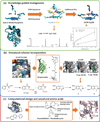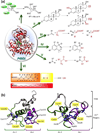Metalloenzyme design and engineering through strategic modifications of native protein scaffolds
- PMID: 24513641
- PMCID: PMC4008701
- DOI: 10.1016/j.cbpa.2014.01.006
Metalloenzyme design and engineering through strategic modifications of native protein scaffolds
Abstract
Metalloenzymes are among the major targets of protein design and engineering efforts aimed at attaining novel and efficient catalysis for biochemical transformation and biomedical applications, due to the diversity of functions imparted by the metallo-cofactors along with the versatility of the protein environment. Naturally evolved protein scaffolds can often serve as robust foundations for sustaining artificial active sites constructed by rational design, directed evolution, or a combination of the two strategies. Accumulated knowledge of structure-function relationship and advancement of tools such as computational algorithms and unnatural amino acids incorporation all contribute to the design of better metalloenzymes with catalytic properties approaching the needs of practical applications.
Copyright © 2014 Elsevier Ltd. All rights reserved.
Figures



References
-
- Lu Y, Berry SM, Pfister TD. Engineering novel metalloproteins: Design of metal-binding sites into native protein scaffolds. Chem Rev. 2001;101:3047–3080. - PubMed
-
-
Richter F, Leaver-Fay A, Khare SD, Bjelic S, Baker D. De novo enzyme design using Rosetta3. PLoS ONE. 2011;6:e19230. • A detailed practical explaination of the use of the Rosetta package to identify scaffolds for enzyme design and the subsequent design and validation steps. A useful introduction for getting started with the approach.
-
Publication types
MeSH terms
Substances
Grants and funding
LinkOut - more resources
Full Text Sources
Other Literature Sources

